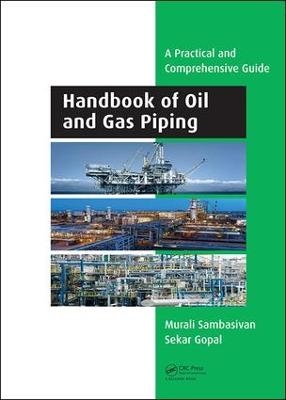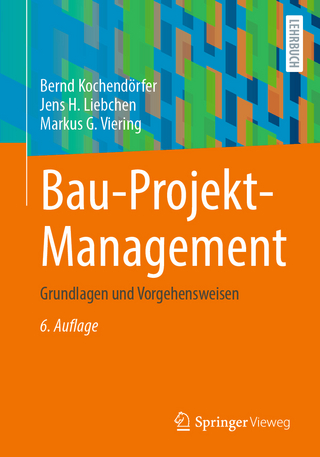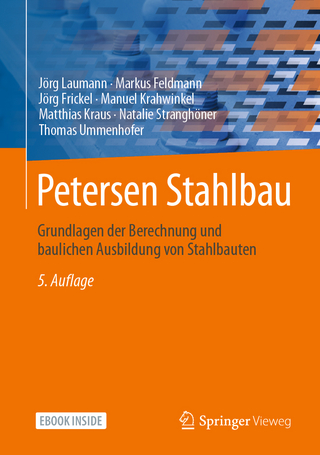
Handbook of Oil and Gas Piping
a Practical and Comprehensive Guide
Seiten
2018
CRC Press (Verlag)
978-1-138-62561-7 (ISBN)
CRC Press (Verlag)
978-1-138-62561-7 (ISBN)
The objective of this practical oil and gas piping handbook is to facilitate project management teams of oil and gas piping related construction projects to understand the key requirements of the discipline and to equip them with the necessary knowledge and protocol. It provides a comprehensive coverage on all the practical aspects of piping related material sourcing, fabrication essentials, welding related items, NDT activities, erection of pipes, pre-commissioning, commissioning, post-commissioning, project management and importance of ISO Management systems in oil and gas piping projects. This handbook assists contractors in ensuring the right understanding and application of protocols in the project.
One of the key assets of this handbook is that the technical information and the format provided are practically from real time oil and gas piping projects; hence, the application of this information is expected to enhance the credibility of the contractors in the eyes of the clients and to some extent, simplify the existing operations. Another important highlight is that it holistically covers the stages from the raw material to project completion to handover and beyond. This will help the oil and gas piping contractors to train their project management staff to follow the best practices in the oil and gas industry. Furthermore, this piping handbook provides an important indication of the important project-related factors (hard factors) and organizational-related factors (soft factors) to achieve the desired project performance dimensions, such as timely completion, cost control, acceptable quality, safe execution and financial performance. Lastly, the role of ISO management systems, such as ISO 9001, ISO 14001 and OHSAS 18001 in construction projects is widely known across the industry; however, oil and gas specific ISO quality management systems, such as ISO 29001, and project specific management systems, such as ISO 21500, are not widely known in the industry, which are explained in detail in this handbook for the benefit of the oil and gas construction organizations.
Features:
Covering the stages from the raw material to project completion, to handover and beyond
Providing practical guidelines to oil and gas piping contractors for training purposes and best practices in the oil and gas industry
Emphasizing project-related factors (hard factors) and organizational-related factors (soft factors) with a view to achieve the desired project performance
Highlighting the roles of ISO management systems in oil and gas projects.
One of the key assets of this handbook is that the technical information and the format provided are practically from real time oil and gas piping projects; hence, the application of this information is expected to enhance the credibility of the contractors in the eyes of the clients and to some extent, simplify the existing operations. Another important highlight is that it holistically covers the stages from the raw material to project completion to handover and beyond. This will help the oil and gas piping contractors to train their project management staff to follow the best practices in the oil and gas industry. Furthermore, this piping handbook provides an important indication of the important project-related factors (hard factors) and organizational-related factors (soft factors) to achieve the desired project performance dimensions, such as timely completion, cost control, acceptable quality, safe execution and financial performance. Lastly, the role of ISO management systems, such as ISO 9001, ISO 14001 and OHSAS 18001 in construction projects is widely known across the industry; however, oil and gas specific ISO quality management systems, such as ISO 29001, and project specific management systems, such as ISO 21500, are not widely known in the industry, which are explained in detail in this handbook for the benefit of the oil and gas construction organizations.
Features:
Covering the stages from the raw material to project completion, to handover and beyond
Providing practical guidelines to oil and gas piping contractors for training purposes and best practices in the oil and gas industry
Emphasizing project-related factors (hard factors) and organizational-related factors (soft factors) with a view to achieve the desired project performance
Highlighting the roles of ISO management systems in oil and gas projects.
Murali Sambasivan is a Professor in the Faculty of Business and Law at Taylor’s University Lakeside Campus, Malaysia. He has a Bachelor and Masters’ degree in Engineering from India and a PhD in Management Science from the University of Alabama, Tuscaloosa, USA. He worked in the industry for 10 years before returning to academia, and has published extensively in several international journals of repute. Sekar Gopal is a Senior Manager (Quality Control) at Muhibbah Engineering Company, Malaysia. He recently obtained his DBA from Universiti Utara Malaysia. Sekar has more than 30 years of work experience in the textile and construction industry.
1 Material
2 Fabrication
3 Welding
4 NDT
5 Erection
6 Pre-commissioning
| Erscheinungsdatum | 05.10.2018 |
|---|---|
| Verlagsort | London |
| Sprache | englisch |
| Maße | 174 x 246 mm |
| Gewicht | 453 g |
| Themenwelt | Technik ► Bauwesen |
| Technik ► Elektrotechnik / Energietechnik | |
| ISBN-10 | 1-138-62561-2 / 1138625612 |
| ISBN-13 | 978-1-138-62561-7 / 9781138625617 |
| Zustand | Neuware |
| Informationen gemäß Produktsicherheitsverordnung (GPSR) | |
| Haben Sie eine Frage zum Produkt? |
Mehr entdecken
aus dem Bereich
aus dem Bereich
Grundlagen und Vorgehensweisen
Buch | Softcover (2021)
Springer Fachmedien Wiesbaden GmbH (Verlag)
37,99 €
Grundlagen der Berechnung und baulichen Ausbildung von Stahlbauten
Buch (2022)
Springer Vieweg (Verlag)
159,98 €
Bemessung von Stahlbauten nach Eurocode mit zahlreichen Beispielen
Buch | Hardcover (2024)
Springer Vieweg (Verlag)
59,99 €


